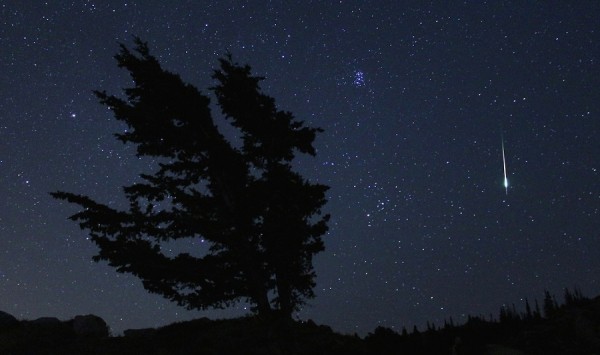By Ana Verayo, | January 24, 2017

In this 20-second exposure, a meteor lights up the sky over the top of a mountain ridge near Park City, Utah. (NASA/Bill Dunford)
Scientists estimate that Earth is being bombarded every year with almost 85,000 asteroids, comets, meteorites and other space debris weighing more than 10 grams.
Apparently, this cosmic debris shower originates from one of the most massive explosion in our solar system that happened some 466 million years ago. This colossal explosion occurred in the major asteroid belt between Mars and Jupiter where two planetary objects collided and broke apart, and pieces of shrapnel were ejected in Earth's direction.
Like Us on Facebook
In this new study, astronomers from the Field Museum of Natural History in Chicago have determined that the type of meteorites that have been falling to Earth since the time of dinosaurs could be the rarest kind in our solar system and even the Milky Way. This would also suggest that the meteorites which are rare today were the common ones across the universe before this collision occurred.
"When you look at all kinds of meteorites falling into the Earth in the last 100 million years, this is not the entire picture of Earth. This is similar to looking outside on a snowy day in winter and believing that every day is snowy, even if it is not snowy in the summer," the lead author of this study, Philipp Heck, who is the Curator of Meteoritics and Polar Studies at the Field Museum, said.
By studying the composition of meteorites that crashed into the planet before this massive planetary collision event 466 millions of years ago, scientists were able to find evidence of micrometeorites which are tiny specks of space rock measuring less than two millimeters. The team found them along the seafloor of the Lynna River in Russia. They are one million years older than that cosmic explosion.
Heck explained that these micrometeorites contain chrome spinels or crystals that have mineral chromite which have remained unchanged for millions of years. These spinels have been unaltered by the passage of time and could reveal crucial clues about their original parent body where all micrometeorites were made of.
After intensive analysis of the micrometeorites, researchers found out the unique chemical composition of these ancient cosmic remnants. More than one-third of these apparently originated from primitive achondrites. Researchers say that most meteorites that fall on Earth are H and L-type chondrites. However, less than half of them are primitive chondrites.
This means that this massive planetary explosion that occurred in the asteroid belt between Mars and Jupiter happened during the Ordovician period.
Heck added that understanding the different kinds of meteorites that have fallen on Earth over millions of years can provide a glimpse of how the major asteroid belt between Mars and Jupiter have evolved and how these types of massive cosmic collisions occur, and ultimately, how our solar system formed.
This new study was published in the journal Nature Astronomy.
-
Use of Coronavirus Pandemic Drones Raises Privacy Concerns: Drones Spread Fear, Local Officials Say

-
Coronavirus Hampers The Delivery Of Lockheed Martin F-35 Stealth Fighters For 2020

-
Instagram Speeds Up Plans to Add Account Memorialization Feature Due to COVID-19 Deaths

-
NASA: Perseverance Plans to Bring 'Mars Rock' to Earth in 2031

-
600 Dead And 3,000 In The Hospital as Iranians Believed Drinking High-Concentrations of Alcohol Can Cure The Coronavirus

-
600 Dead And 3,000 In The Hospital as Iranians Believed Drinking High-Concentrations of Alcohol Can Cure The Coronavirus

-
COVID-19: Doctors, Nurses Use Virtual Reality to Learn New Skills in Treating Coronavirus Patients







